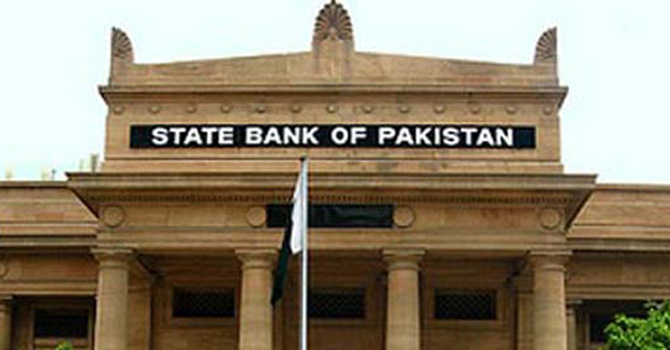KARACHI: The State Bank of Pakistan (SBP) governor, on Friday, increased the discount rate by 25 basis points to 6 per cent after a gap of 19 months due to a rising current account deficit.
In May 2016, the SBP had decreased the discount rate by 25 basis points to 5.75 per cent following the stability in the country’s economy.
Governor SBP Tariq Bajwa in a crowded press conference said that, overall economy of the country is better and the SBP has projected 5.8 per cent Gross Domestic Product (GDP) growth in the current fiscal year against a projected target of 6 per cent for this year.
The governor said, “Based on these developments, the Monetary Policy Committee is of the view that in order to preempt overheating of the economy and inflation breaching its target rate, this is the right time to make a policy decision that would balance growth and stability in the medium to long-term. Accordingly, the Monetary Policy Committee has decided to raise the policy rate by 25 basis points to 6 per cent.”
Pakistan’s economic growth is on track to achieve its highest level in the last eleven years. Average headline inflation remains within the forecast range of SBP, but core inflation has continued to increase. Fiscal deficit for the first half of fiscal year 2018 (H1-FY18) is expected to fall close to last year’s 2.5 per cent. There has also been visible improvement in export growth and remittances are marginally higher. However, largely due to a high level of imports the current account deficit remains under pressure. The December 2017 exchange rate adjustment is expected to help ease pressure on the external front.
The progress in the real sector indicates that agriculture sector is set to perform better for the second year in a row. Production of all major Kharif crops, except maize, has surpassed the level of FY17.
Similarly, large scale manufacturing (LSM) recorded a healthy broad-based growth of 7.2 per cent during July-November FY18 as compared to 3.2 per cent during the same period last year.
While there could be some deceleration in LSM growth due to sector-specific issues such as sugar, petroleum and fertiliser, overall industrial activity is likely to remain strong.
Benefiting from both infrastructure and China-Pakistan Economic Corridor (CPEC) related investments, construction and its allied industries are expected to maintain their higher growth momentum.
After incorporating the impact of commodity sector dynamics on the services sector, the real GDP growth is projected to be around 5.8 per cent, significantly higher than FY17, but marginally lower than the annual target of 6 per cent for FY18. This is largely due to expectations of a below-target wheat crop because of a reduction in area under cultivation.
Average headline inflation for H1-FY18 stands at 3.8 per cent. Meanwhile, core inflation (excluding food and energy) continued to maintain its higher trajectory and clocked in at 5.5 per cent during the first half of the year as compared to 4.9 per cent last year. High core inflation together with a lagged impact of the Pakistani Rupee’s depreciation and rising international oil prices are likely to increase inflation in the coming months. Taking into account the impact of all these developments, while the average inflation for FY18 is still projected to fall in the range of 4.5 to 5.5 per cent, end of fiscal year Year on Year (YoY) inflation is likely to inch towards the annual target of 6 per cent.
Broad money supply grew marginally by 1.9 per cent during H1-FY18. This is a reflection of the decline in Net Foreign Assets (NFA) and the government’s efforts to contain expenditures.
Higher tax collection and proceeds from the issuance of Sukuk and Eurobond have led to a reduction in net budgetary borrowing which stood at Rs 401.9 billion during H1-FY18 as compared to Rs 470.4 billion in the corresponding period of the previous year. Moreover, the delay in the sugar crushing season also contributed to a moderation of demand in private sector credit.
On the external front, export receipts posted a growth of 10.8 per cent in H1-FY18 which is the highest growth in the last seven years against a reduction of 1.4 per cent in H1-FY17. Worker’s remittances also recorded a growth of 2.5 per cent during the first half of the year as compared to a decline in the same period last year.
However, favourable impact of these positives was overshadowed by the continuation of strong growth in imports of goods and services. The current account deficit widened to $7.4 billion during the first half of the year, which is 1.6 times the deficit during the same period last year.
Developments in financial accounts show that one-fifth of this deficit was financed by healthy foreign direct investments inflows, and the rest was managed by the official flows and the country’s own resources. As a result, SBP’s liquid foreign exchange reserves witnessed a decline of $2.6 billion since end June 2017 to reach $13.5 billion as of 19th January 2018.
Four key factors of Pakistan’s economy have witnessed important changes since November 2017 impinging upon the policy rate decision. Firstly, the Pakistani Rupee has depreciated by around 5 per cent. Secondly, oil prices are currently hovering near $70 per barrel. Thirdly, a number of central banks have started to adjust their policy rates upwards adversely affecting the Pakistani Rupee interest-rate differentials vis-à-vis their currencies. Fourthly, multiple indicators show that the output gap has significantly narrowed indicating a buildup of demand pressures.
Going forward, the Pakistani Rupee’s depreciation in December 2017, the export package, the lagged impact of adjustments in regulatory duties, favourable external environment, and an expected increase in workers’ remittances are expected to contribute to a gradual reduction in the country’s current account deficit.
While the increase in international oil prices poses a major risk to this assessment, managing the overall balance of payments in near term depends on the realisation of official financial flows.
























